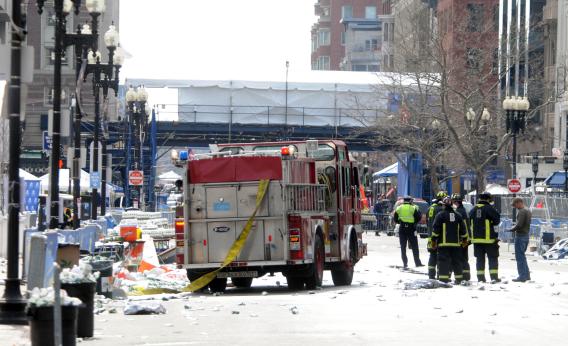How Do Bomb-Sniffing Dogs Sniff Bombs?
And other questions about the aftermath of the Boston Marathon explosions.

Photo by Darren McCollester/Getty Images
FBI agents and Boston police are still investigating the explosions at the Boston Marathon on Monday that killed at least two and injured many others. Police have said the blasts were caused by bombs of some kind. Below are questions Slate has tackled in the aftermath of other bombings.
Early reports indicate that the first explosion blew out windows in four buildings near the finish line. How do investigators measure bomb strength?
By checking the walls, probably. Forensic investigators can estimate a bomb's strength by examining its effects on nearby walls, windows, cars, and human victims. For example, a 7-kilogram TNT bomb detonated in a relatively open space might crack a brick wall 45 feet away. The explosion would damage plaster walls and asbestos shingles at around 115 feet. Single-strength window glass would shatter at a distance of 210 feet. Human eardrums could be damaged within 40 feet, and there's a chance that anyone within 12 feet would die. These estimates, however, are extremely rough.
Most bomb units carry ion mobility detectors. The handheld units, which look like cordless drills, suck in a sample of air and look for tiny bits of unexploded chemicals. If they find even a single nanogram of explosive, a red light indicates its presence. The technology is the same as that used in airport security screening, but more portable. The sooner the machine gets to the scene, the better. Explosives aren't particularly volatile, so they don't hang around in the air for long. (Read more about how police investigate bomb blasts.)
Witnesses at the marathon finish line reported seeing white smoke after the blasts, as shown in video footage. Does white smoke tell us anything about the bomb? What makes some smoke white and other smoke black?
The type of fuel and how hot it's burning. In general, a hotter fire will convert more fuel into elemental carbon, which forms into tiny particles that absorb light and appear in the sky as black smoke. A cooler combustion—or one that doesn't work as efficiently—yields less-pure forms of carbon. These tend to reflect light, making the smoke look white. The basic by-products of a fire are carbon dioxide and water. You can't see carbon dioxide, but water in the air might make smoke appear lighter in color. The steam produced by a wood fire can turn into a white, pyrocumulous cloud that mixes with black smoke and makes it look gray.
An oil fire tends to burn very black because most of the fuel is converted into elemental carbon. There's also very little moisture in the oil to make the smoke look lighter. Plastic products, which are made from petroleum products, also release dark-colored smoke. (Read more about smoke color.)
Police have deployed bomb-sniffing dogs in the vicinity of the Boston blasts. How do dogs learn to smell bombs?
Classical conditioning techniques using food rewards and toys. In the United States, the Bureau of Alcohol, Tobacco, Firearms and Explosives; Customs and Border Protection; and private dog trainers teach bomb-sniffing dogs. The Labrador retriever is a favored breed due to its lack of aggression in high-intensity situations.
During the ATF's 10-week program, a dog is exposed to an explosive up to 120 times a day, in amounts ranging from 1,000 pounds to 1 gram. In early phases of training, the dog is told to sit each time he finds the odor—that becomes the signal he uses to alert his handler when a bomb is present. The dog is fed only when in the presence of the explosive. Using a food reward instead of praise and play prevents an exclusive bond between dog and handler, which might prevent the dog from working well with others.
One upper-level training scenario uses a rotating wheel with slots for four containers. Some of the containers are empty; others hold explosives, a distracting object such as food, or an explosive combined with a distracting odor. By using the training wheel, the dog learns to ignore food in favor of explosives. Some agencies avoid mixing food with work and infuse dog toys with explosive odors instead. The dogs learn to root out hidden explosives by simply playing fetch.
The dog must learn to recognize thousands of active ingredients that might be used in an explosive. Trainers expose the canine to signature compounds that are found in many different types of explosives. In this way, a dog can be trained to detect all manner of bombs by memorizing a dozen or so smells. Some bomb components are more odoriferous than others. C-4 has an incredibly strong scent; it's followed in decreasing order of smelliness by dynamite, TOVEX, detonating cord, and TNT. (Read more about training bomb-sniffing dogs.)